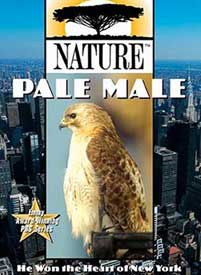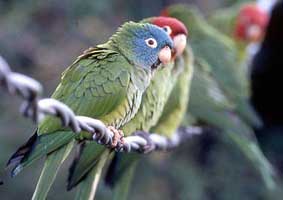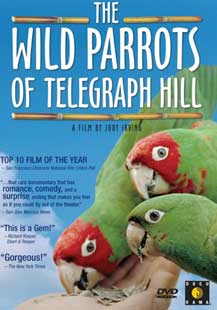 The documentary Pale Male (2002) was first aired on the PBS program Nature. It's one of the coolest nature films I have ever seen, chronicling the arrival in New York's Central Park of a male red-tailed hawk, his temporary disappearance & return with a mate, & the subsequent family of hawks established in the park. The documentary Pale Male (2002) was first aired on the PBS program Nature. It's one of the coolest nature films I have ever seen, chronicling the arrival in New York's Central Park of a male red-tailed hawk, his temporary disappearance & return with a mate, & the subsequent family of hawks established in the park.
The film is frankly awesome. Red-tail hawks had not previoiusly lived in Central Park, until that lone male showed up. As he was a paler color than most red-tails, birdwatchers dubbed him Pale Male. Adaptation to city life was full of perils, but Pale Male thrived on a diet of pigeons, rats, & squirrels. He would eventually outlive three mates, & raise several broods in a nest on the side of an old apartment building.
In the perilous city not all these hawks fared as well as Pale Male. Because pigeons are sometimes illegally poisoned, & rodents legally poisoned, feasting on sick or dead animals can kill hawks. Pale Male apparently was never much of a scavenger & so evaded poisoned meals. The smartest most adaptable offspring slowly increased the park's population so that they are now a regular feature of city life.
The natural history of city birds, how they survive & raise young in close proximity to human beings, is intensely interesting, & if the film weren't also about people it'd still be awe-inspiring because these birds are incredible, with photography quite an achievement for Frederic Lilien's impressive skill & patience.
But it's also about the hawk-people who set up hawk-watch stations. The birds bring people together in friendship. It brings out the most positive aspects of eccentricity among people who are devoted to observing the lives of these hawks. The number of people who gathered daily waiting to be witness to the first nestlings' first practice flights makes humanity, no less than avian society, seem like worthwhile likeable creatures.
Pale Male is a film of great beauty, its impact heightened by what can only be described as an unpretending instinctual human spirituality that finds ways to commune with nature even in America's largest & most populace of bustling cities.
 At first blush, I was a little disappointed in The Wild Parrots of Telegraph Hill (2003), as I'd been led to believe it was going to be the natural history of wildlife in the urban setting, something that does for parrots of San Francisco what Pale Male did for hawks of New York city. Wild Parrots requires some forgiving in order for its finer attributes to be appreciated. At first blush, I was a little disappointed in The Wild Parrots of Telegraph Hill (2003), as I'd been led to believe it was going to be the natural history of wildlife in the urban setting, something that does for parrots of San Francisco what Pale Male did for hawks of New York city. Wild Parrots requires some forgiving in order for its finer attributes to be appreciated.
It is really a document about the parrot man of Telegraph Hill. The parrots are not incidental, but we get no real picture of the parrots' lives apart from their feeding station & their interactions with Mark Bittner. It could as well be titled The Glorious Birdfeeder: Life & Times of Mark Bittner.
The most memorable of the birds is Mingus, the one cherry-headed Conure who wanted to stay in captivity & whom Mark could not convince to remain with the flock. Mingus had a crippled leg that made life in the flock a mite harder. He also had a crabby disposition. When he misbehaves, Mark turns him loose outside, & Mingus so worries he's being forced to join the flock that he becomes more loving when let back in.
At times, documentarian Judy Irving makes Mark seem like the next-worst thing to a hobo who has no visible means of support, is a long-tolerated squatter on the verge of eviction, & has no purpose in his aimless life except to hang out with semi-feral parrots. Although the ad-writers call him "a dharma bum" & "a Bohemian St. Francis," the camera's eye captures a greasy-haired dork who'd rather get laid if only it were possible, but since it's not possible, he'll settle for birds.
It's actually a little off-putting how much of a loser the camera's eye makes of Mark's lazy-ass existence & borderline looniness. Parts of the film function almost like an editorial suggesting that only someone with no life, no income, self-deluded, without talent, & who can't get laid, is the sort of person who might devote themselves to animals, whether it's Mark's obsessive concern for parrots, or Jane Goodall's for chimpanzees. And a film about Goodall certainly could be framed in a hostile manner as the tale of an evil mother who cared more about apes than her own angry son. The camera is rarely objective, & the relentless view of Mark as a dork gets dispiriting.
But in the last scenes of the film this superficially hostile impression of Mark as a loser is completely turned inside out & the seemingly unfair judgmental portrait turns into irony, for Mark is finally viewed with loving admiration, his loserliness merely an inside joke between Mark & the filmmaker, & not a betrayal of the subject's trust.
It is so much about Mark & so little about the birds that one must adore Mark to adore this film. And it isn't too difficult to do so. Still I do wish it had gotten more into what the birds' lives were like apart from feeding stations, though what we see from feeding stations is charming enough.
The other bird who stood out was Connor, the only blue-crown conure among the cherry-heads. Like Mark himself, Connor is a semi-outsider, & he seems such a heroic guy whose need for companionship causes him to befriend & even protect outcast members of a flock & even to bond however reluctantly with an annoyingly affectionate budgie.
There are extras & updates on the dvd of considerable interest, & deleted scenes that were not in the main film only to keep it within length. The follow-up on the life of Mingus was especially heartwarming.
copyright © by Paghat the Ratgirl
|

